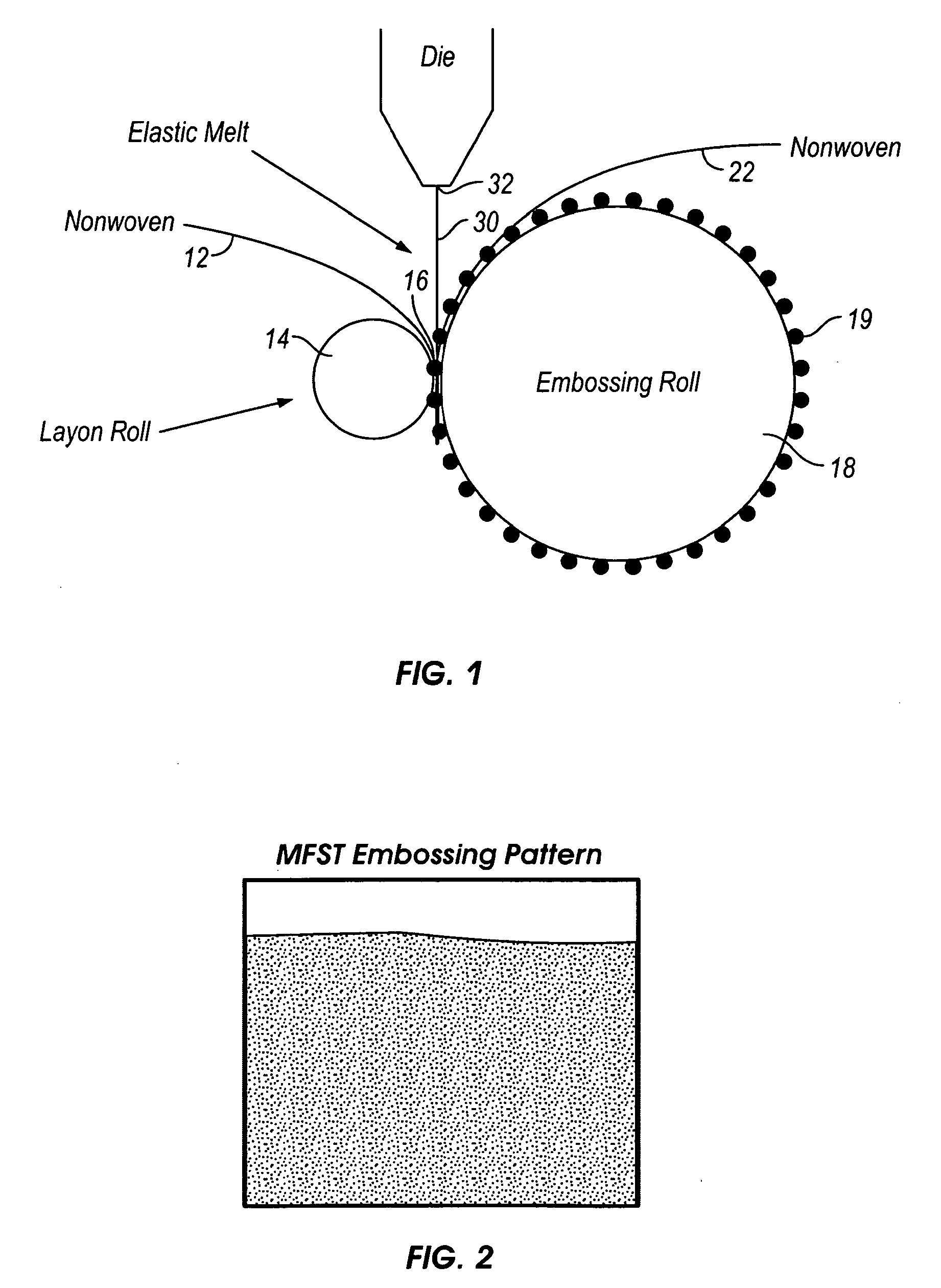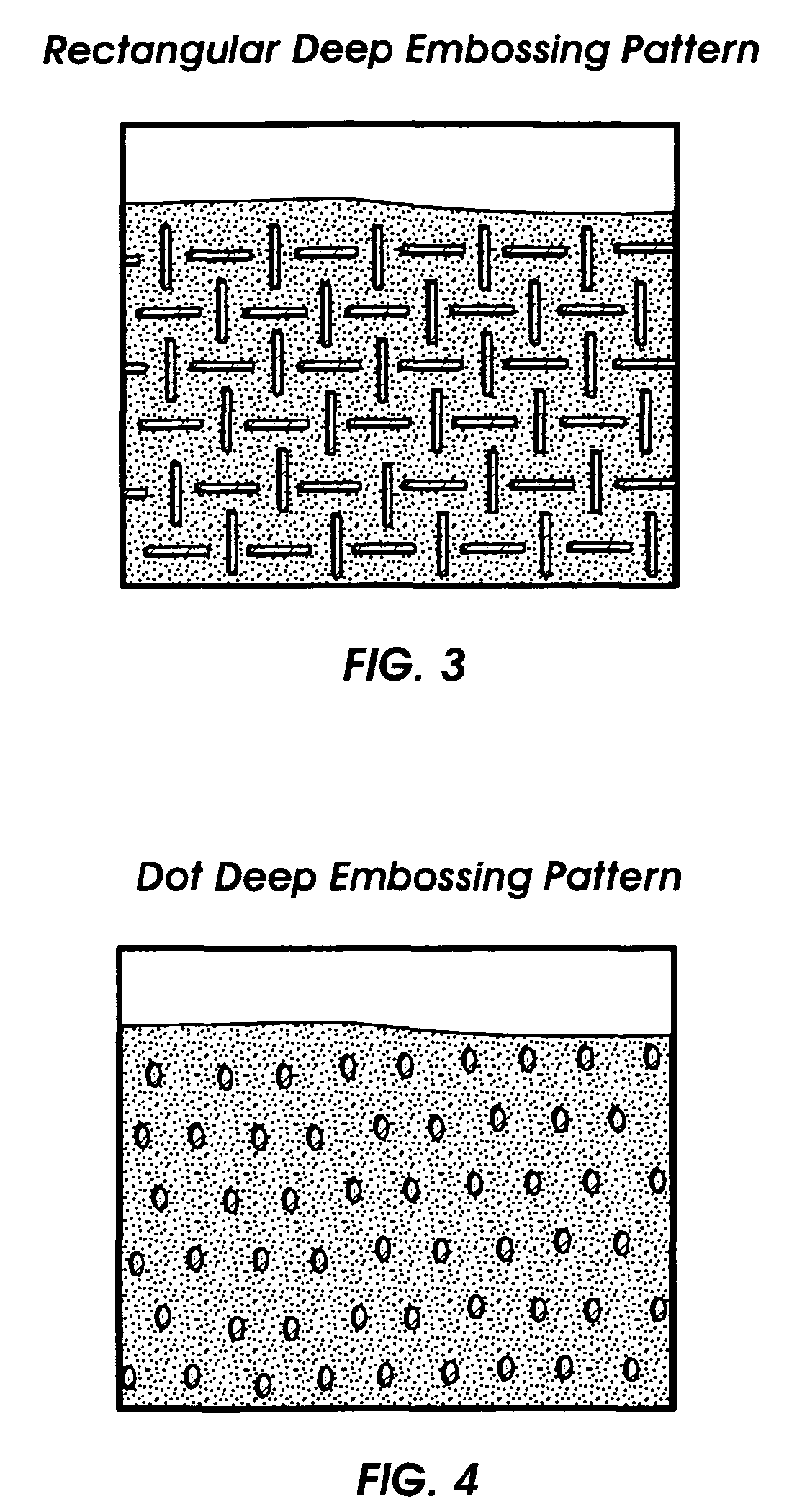Stretchable elastic laminate having increased CD elongation zones and method of production
a technology of elastic laminates and stretchable strips, which is applied in the direction of weaving, transportation and packaging, chemistry apparatuses and processes, etc., can solve the problems of increased manufacturing costs, striated appearances that may not be aesthetically pleasing, and nonwoven webs to become thicker, so as to improve elongation and breakage, improve stretch properties, and low permanent deformation
- Summary
- Abstract
- Description
- Claims
- Application Information
AI Technical Summary
Benefits of technology
Problems solved by technology
Method used
Image
Examples
example 1
[0081]A three layer extrusion laminate was prepared by extruding a melt of an elastic resin from a die, such as die 32 shown in FIG. 1, into the nip between a layon roll, and an embossing roll, such as layon roll 14 and embossing roll 18 shown in FIG. 1. The layon roll employed in this Example is a silicone rubber roll having a surface pattern of alternating lands and grooves extending in the machine direction across the entire surface of the roll. Each of the grooves had a width of 0.250 inches, and a depth of 0.125, and each of the lands had a width of 0.250 inches. The surface of the embossing roll employed in this Example has a male fine square taffeta (MFST) embossing pattern, (See FIG. 2). The melted elastic layer is a multi-layer structure formed from a co-extruded melt wherein the outer layers of the co-extruded multi-layer structure are tie layers and the core layer is a styrene-ethylene / butylene-styrene resin available from Kraton Polymers of Houston, Tex. under the trade ...
example 2
[0085]A three layer extrusion laminate was prepared in the same manner as Example 1, using the same elastic resin melt and the same PET spunlace nonwoven material for the first and second nonwoven layers as the laminate made in Example 1, except that the embossing roll is provided with the deep rectangular embossing pattern illustrated in FIG. 3. The resulting laminate had a basis weight of 126.16 gsm.
example 3
Comparative
[0086]A three-layer extrusion laminate was prepared in the same manner as Example 2, using the same elastic resin and the same PET spunlace nonwoven material for the first and second nonwoven layers as the laminate made in Example 2, except that the layon roll is provided with a smooth or flat silicone rubber surface rather than the grooved surface used in Example 2. The resulting laminate had a basis weight of 121.88 gsm.
[0087]Each of the laminates made in Examples 1-3 were tested to measure the force during extension and retraction in 100% hysteresis tests using an Instron mechanical testing machine. The test is a cyclic test to 100% elongation. The initial crosshead gap is 1″ and the jaw separation is 20″ / minute. Three cycles are made without pause between the starting point and 100% elongation. On each cycle, the force is measured at extension (load) at 25, 50, 75 and 100% and during retraction (unload) at 25, 50 and 75%. The results for Examples 1-3 are set forth bel...
PUM
| Property | Measurement | Unit |
|---|---|---|
| depth | aaaaa | aaaaa |
| width | aaaaa | aaaaa |
| melting point | aaaaa | aaaaa |
Abstract
Description
Claims
Application Information
 Login to View More
Login to View More - R&D
- Intellectual Property
- Life Sciences
- Materials
- Tech Scout
- Unparalleled Data Quality
- Higher Quality Content
- 60% Fewer Hallucinations
Browse by: Latest US Patents, China's latest patents, Technical Efficacy Thesaurus, Application Domain, Technology Topic, Popular Technical Reports.
© 2025 PatSnap. All rights reserved.Legal|Privacy policy|Modern Slavery Act Transparency Statement|Sitemap|About US| Contact US: help@patsnap.com



